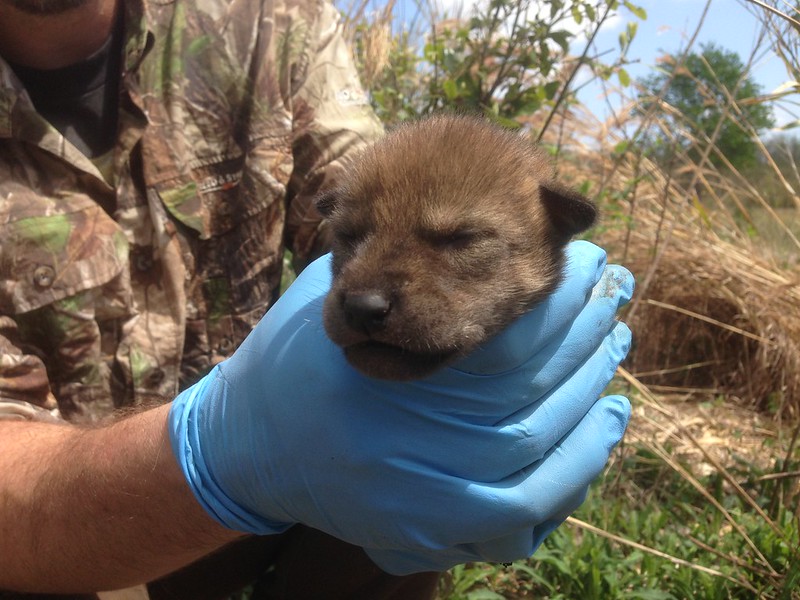Alligator River/Pea Island National Wildlife Refuge P. O. Box 1969 Manteo, North Carolina 27954 Contact: Bonnie Strawser - 252-473-1131 |
 |
 |
News
Release
FOR IMMEDIATE RELEASE June 11, 2013 Contacts:
David Rabon, Red Wolf Recovery Program Coordinator, david_rabon@fws.gov, 252-473-1132
Tom MacKenzie, tom_mackenzie@fws.gov, 404-679-7291, M: 678-296-6400

The final red wolf pup count for the 2013 whelping season has been tallied. Thirty-four pups in seven litters were found in the restored red wolf population in eastern North Carolina. These numbers are down slightly from recent years’ pup counts. The Red Wolf Recovery Program reported 39 pups from nine litters born in the wild in 2012, 40 pups from 10 litters in 2011, and 43 pups from nine litters in 2010. The Red Wolf Recovery Program also reported 23 pups from 4 litters born in zoos and nature centers participating in the Species Survival Plan captive breeding program. In addition, as part of our efforts to increase the genetic diversity of the wild population, a captive-born pup was fostered into a wild-born litter to be raised as a wild wolf. Reasons for the decline in the number of pups born in the wild this year are not apparent.
The red wolf (Canis rufus) is one of the world’s most endangered wild canids. Once common throughout the southeastern United States, red wolf populations were decimated by the 1960’s due to intensive predator control programs and loss of habitat. A remnant population of red wolves was found along the Gulf Coast of Texas and Louisiana. After being declared an endangered species in 1967, efforts were initiated to locate and capture as many wild red wolves as possible. Of the 17 remaining wolves captured by biologists, 14 became the founders of a successful captive breeding program. Consequently, the United States Fish and Wildlife Service declared red wolves extinct in the wild in 1980.
The first litter of red wolves born in captivity occurred in 1977. By 1987, enough red wolves were bred in captivity to begin a restoration program on Alligator River National Wildlife Refuge in northeastern North Carolina. Since then, the experimental population area has expanded to include three national wildlife refuges, a Department of Defense bombing range, state-owned lands, and private property, spanning a total of 1.7 million acres.
About 100 red wolves roam their native habitats in five northeastern North Carolina counties. Additionally, nearly 200 red wolves comprise the Species Survival Plan captive breeding program in sites across the United States, still an essential element of red wolf recovery. Interbreeding with the coyote (Canis latrans), a species not native to North Carolina, has been recognized as a threat affecting restoration of red wolves in this section of their historical home range. Currently, the Red Wolf Recovery Program is using adaptive management strategies to reduce the threat of coyotes while building the wild red wolf population in northeastern North Carolina. In addition, the North Carolina Wildlife Resources Commission is committed to working with the Fish and Wildlife Service in the development of a comprehensive canid management plan that includes methods for controlling coyote populations and incorporates the conservation goals of the red wolf.
The red wolf is one of two species of wolves in North America, the other being the gray wolf, (Canis lupus). As their name suggests, red wolves are known for the characteristic reddish color of their fur most apparent behind the ears and along the neck and legs, but are mostly brown and buff colored with some black along their backs. Intermediate in size to gray wolves and coyotes, the average adult red wolf weighs 45-80 pounds, stands about 26 inches at the shoulder and is about 4 feet long from the tip of the nose to the end of the tail.
Red wolves are social animals that live in packs consisting of a breeding pair and their offspring of different years, typically five to eight animals. Red wolves prey on a variety of wild mammals such as raccoon, rabbit, white-tailed deer, nutria, and other rodents. Most active at dusk and dawn, red wolves are elusive and generally avoid humans and human activity.
To learn more about red wolves and the Service’s efforts to recover them, please visit www.fws.gov/redwolf.
The mission of the U.S. Fish and Wildlife Service is working with others to conserve, protect, and enhance fish, wildlife, plants, and their habitats for the continuing benefit of the American people. For more information on our work and the people who make it happen, visit www.fws.gov. Connect with our Facebook page at www.facebook.com/usfwssoutheast, follow our tweets at www.twitter.com/usfwssoutheast, watch our YouTube Channel at http://www.youtube.com/usfws and download photos from our Flickr page at http://www.flickr.com/photos/usfwssoutheast.
source

No comments:
Post a Comment